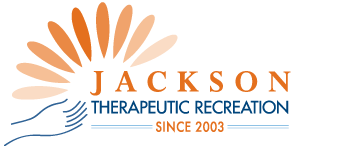 https://jacksontr.com/wp-content/uploads/2022/06/Depresssion.jpg
837
1254
Matt Jackson
https://jacksontr.com/wp-content/uploads/2023/02/JACKSER001logo_Since2003.png
Matt Jackson2022-06-10 10:20:082022-06-15 11:16:46Therapeutic Recreation Programming for People Displaying Symptoms of Depression
https://jacksontr.com/wp-content/uploads/2022/06/Depresssion.jpg
837
1254
Matt Jackson
https://jacksontr.com/wp-content/uploads/2023/02/JACKSER001logo_Since2003.png
Matt Jackson2022-06-10 10:20:082022-06-15 11:16:46Therapeutic Recreation Programming for People Displaying Symptoms of DepressionAdapting and Modifying Activities for Changing Abilities
A regular part of your life as a caregiver is adapting and modifying activities for the changing needs, challenges and abilities of the person being cared for. Similarly Recreation Therapists do the same thing with the therapeutic programs they design and deliver for their clients. Generally the core of every design is this: the client should be able to succeed at whatever the activity is. So the activity has to match their abilities.
With this in mind this post will build your skills as a caregiver at adapting and modifying activities. To begin with we will provide a way to view any game, project or chore that you do with the person being cared for. Further you will learn how to adapt on the fly to changes in abilities. At the same time you will ensure they can succeed at it while still being challenged a bit.
Changes in Abilities: Day-to-Day and Over Time
Generally these changes can stem from the “good days and bad days” associated with some forms of dementia, mood, medications, time of day or shifting sleep patterns just to name a few. Correspondingly there can be impacts on things such as vision, fine motor skills (like using fingers), gross motor skills (like moving an arm), speech, cognitive ability, or attention span.
To be sure, adapting and modifying activities to accommodate these changes means more than ensuring success. Not only will you will get more use from one particular activity, but you will keep the person receiving care engaged and involved more often. Additionally you will provide both yourself and them some consistency with what you do together despite changing conditions.
3 Variables to Work With for Every Activity
Consider the following 3 things as the building blocks of every activity.
Materials
Firstly, examine the physical components of the activity, like brushes, tools, paper, etc. For example, are they easy to hold, non-slip, easy to clean? Are there sounds involved as well as touch?
Environment
Likewise, look at the conditions in which the activity is done. For instance think of things like lighting, background noise, clutter, and ease of movement.
Rules / Procedures
Lastly, think about the non-physical elements of the activity. For example consider how many steps are involved or how long the activity takes. Additionally, count how many decisions are needed and how complex these decisions are. How easy is it to make mistakes? Further, what are the impacts of any mistakes that can be made? The less impact the better.
Each of these can be adjusted to accommodate changes to the participant’s abilities.
Tip from the pros: A well-designed activity will have elements build right in that are easily adjusted as needed.
To illustrate here is an example of a simple activity that is easily modified. This activity primarily engages cognitive function, but also fine motor skills.
Photo Album Activity
Select a topic that is of interest to the person, such as birds, cars, flowers, etc. In this case we’ll use birds.
What you’ll need:
- A binder that can zip closed, with pockets and some pages inserted
- Colour pictures printed and cut out of 3-6 different coloured birds that the person will recognize, both male and female, for example cardinals, blue jays, or gold finches.
- One picture mounted on each page of the binder
- Descriptive words that apply to each picture, such as “cardinal”, “red”, “male”, typed, printed, cut out and pasted onto stiff cardboard so they last longer
- Choose an easy-to-read font like Arial or Helvetica, and large enough letters for the person’s vision
- Blue putty on the back of each word (optional)
Steps for the activity:
Firstly, ensure the person is seated either at a table or so they can work on their lap. Secondly, cue them to open the photo album.
- Undo the zipper on the photo album
- Remove all the descriptive words and place them face up on the table
- Identify the first picture
- Place all matching descriptive words under the picture (optional putty on the back of each word to stick to the page)
- Turn the page and repeat until finished
- Collect all the descriptive words and put them back in the pocket of the album
- Zip the album back up.
Now you have the plan for the activity. So, how can we go about adapting and modifying this activity to accommodate changes in the person’s abilities? To illustrate this let’s go through the 3 Variables and look at some possible ways to achieve this:
Adapting and Modifying Materials
Vision
Make it easier: Print the words in a larger font
Fine motor skills
Make it easier:
- Glue words onto cut-out pieces of foam core so they are more like tiles and easier to pick up
- Attach words instead onto folded pieces of cardboard so they can sit “tented” on the table and can be pinched to pick them up and dropped under the picture.
Adapting and Modifying Environment
In this situation, standard adaptions for adequate light and background noise can be made. If sitting at a table is doesn’t work perhaps a tray table on the person’s lap would be easier.
Adapting and Modifying Rules / Procedures
The number of steps involved
Make it easier:
- Start with the album unzipped
- Start with the words already laid out on the table
- Only pick 1 word for each picture instead of all that apply
Fine motor skills
Make it easier:
- Just point to the matching words instead of picking them up
Cognitive ability
Make it easier:
- Reduce the number of pictures by taking pages out of the album (and removing the related words)
- Reduce the number of possible words that match each picture (i.e. just lay out the descriptive words for colours, or just the names of the birds)
- Include pictures of very different things, like a bird, a flower, a car, a house, and the matching words are simply “bird”, “flower”, “car”, “house”
Conversely, make it harder:
- After each page is done move the words back onto the table with all the other words
- Mix in pages with pictures of different kinds of items, like adding flowers (with words like name, colour, flowering month). Alternatively you could use cars (with words like make, model, colour, year). You will need more descriptive words prepared!
- Place the words in alphabetical order under each picture
Adapting and Modifying Activities: Conclusion
Clearly the purpose of each of the built-in ways to modify the activity is to match the activity to the person’s abilities on a given day. As a result there is always a way for you to help them successfully engage in the activity and complete it while still offering an amount of challenge.
To this end you can examine any activity with an eye on materials, environment and rules / procedure to help ensure success.
- Where is the person having a hard time? What is it related to?
- Are there points where they get frustrated?
- Can you figure out the source of frustration by changing one thing at a time?
To support your work as a caregiver you will find included with this post the Adapting and Modifying Activities Guide and Evaluation Tool. This includes a checklist of things to consider plus a way to measure and evaluate where some changes might need to be made.
In conclusion we hope this provides tools to not only come up with well-designed activities but also trouble-shoot existing ones.
References
Dattilo, J., (1998). Leisure education program planning. A systematic approach. Third edition. Pennsylvania Venture Publishing Inc.




